Type species: Perisomena caecigena (Kupido, 1825).
A genus (or subgenus according to some authors) of one species endemic to the western palaearctic and which is closely related to Rinaca Walker, 1855, from the eastern palaearctic, as well as Neoris. Included in the closely related genus Saturnia by some authors. Treated as a valid genus by Rubinoff & Doorenweerd (2020), even though mitochondrial DNA barcode analysis indicates that this taxon may belong in the genus Rinaca Walker, 1855, along with all species of what were Caligula (Nässig, Naumann & Löffler, 2016).
HOSTPLANT FAMILIES: Mainly trees in the genus Quercus (Fagaceae).
UK: Autumn Emperor Moth, F: Bombyx à ocelles aveugles, D: Blindaugenspinner; Ockerfarbener Pfauenspinner, NL: Herfstnachtpauwoog, CZ: Martináč slepý, H: Balkáni pávaszem, FIN: Kaakonriikinkukkokehtääjä.
Saturnia caecigena Kupido, 1825, Neuentdectes europäisches Nacht-Pfauen-Auge, Saturnia caecigena 4: 5.
Type locality: Fiume, Yugoslavia [Rijeka, Croatia].
[Further details on this species, as well as photos of all stages, can be found on - Lepiforum.]
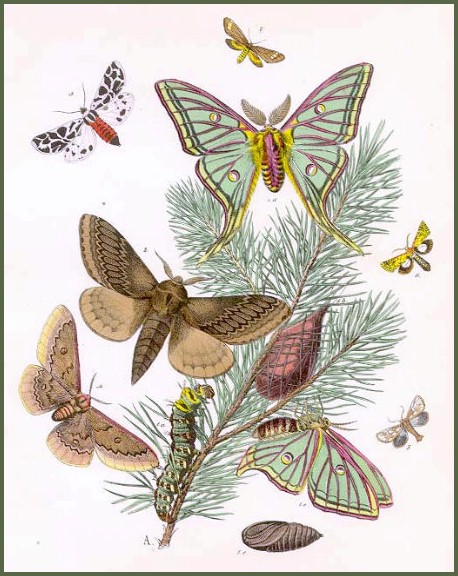
Holarctic; western Palaearctic region. Pleistocene refuge: Monocentric -- Pontomediterranean subsection of the Mediterranean refuge.
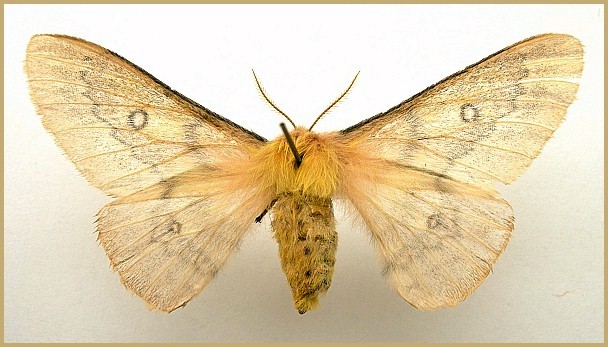
Wingspan 62--88mm. The thinly-scaled adults can be weakly marked, but usually bear an antemedial and postmedial band on each wing, each of which bears a small dark-ringed 'blind' eyespot. Females are basically reddish-brown to pale wine-red with some yellowish markings, the males pale sandy yellow to deep yellow with reddish markings along the postmedial bands, although this does vary. The latter bear exceptionally large, pectinate antennae.
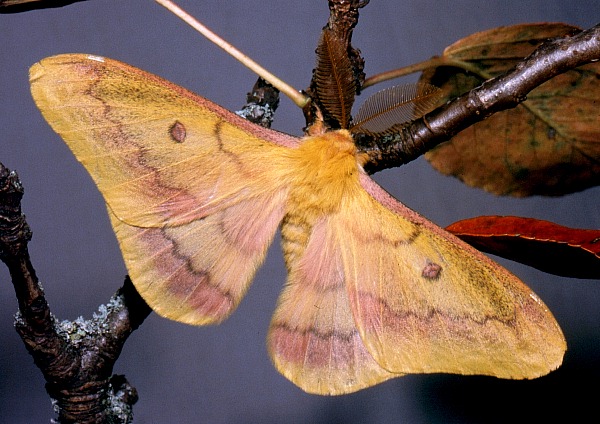
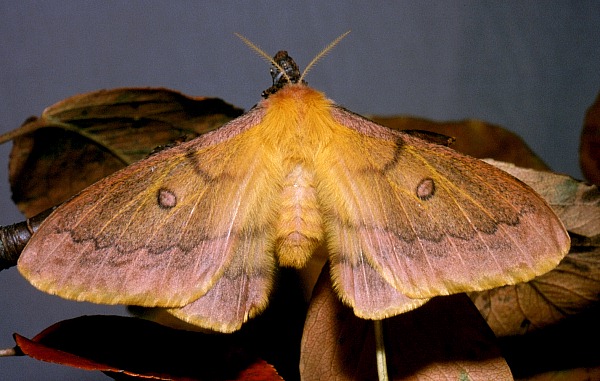
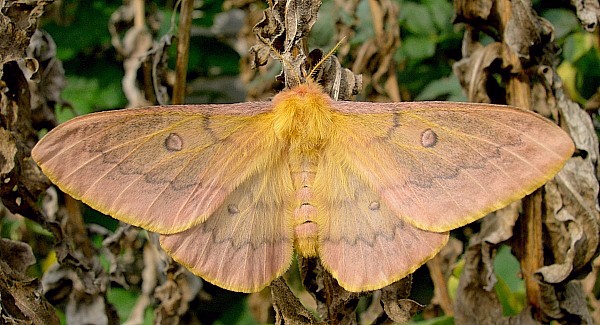
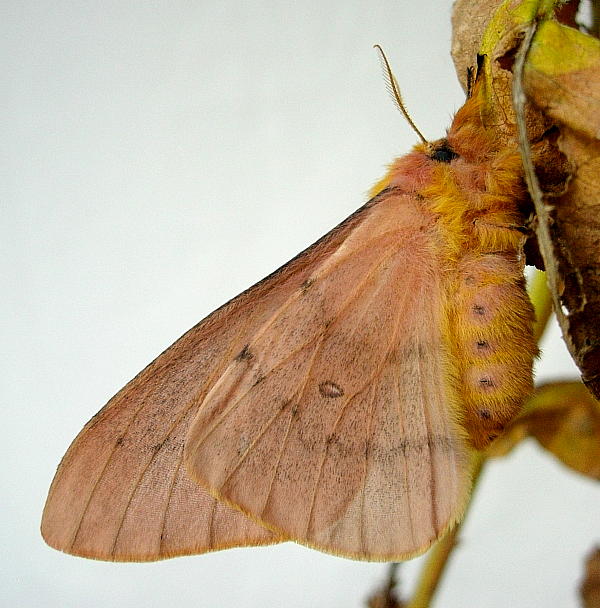
A nocturnal subspecies inhabiting dry, shrubby, open woodland with oaks (Quercus). This subspecies starts to emerge after the onset of cool and misty autumn nights, generally during mid afternoon, having spent the summer as a pupa. Males start to fly about an hour after darkness falls, preferring cool (or even cold), moist conditions. Females start to call (scent) about 2 hours after darkness, and can attract many males. Both sexes remain active down to temperatures of 2°C, and will even tolerate mild frosts. Males come to light, and many can frequently be seen frantically dashing around in the beams of car headlights when driving through favoured woodlands.
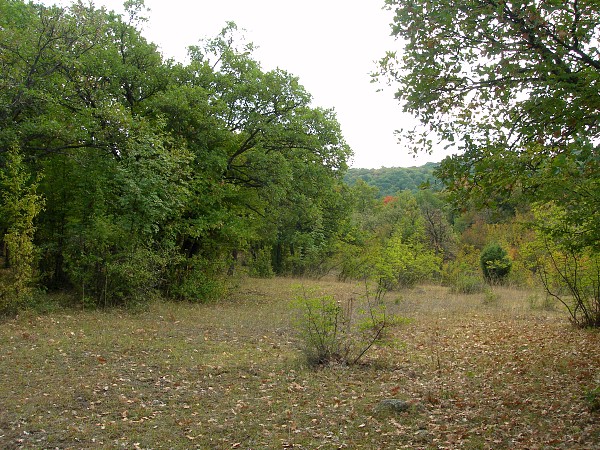
At rest the wings are held in a V-shape over the back in a manner similar to that of Aglia tau.
This is a short-lived, frantic species. Most individuals pair on the first night after emergence, this activity taking between 15 minutes and 2 hours. The females then try to deposit all their eggs that night, and the remaining few during the next night. Few adults live more than 3-4 days once paired.
Depending on latitude and altitude, late September to early November, with most out in October.
OVUM: Oval, 2.5 x 2mm, glossy cream with brown gum. Females lay up to 100 eggs in batches of up to six on the twigs of trees. These hatch the following spring with the onset of warmer weather. The overwintering stage.
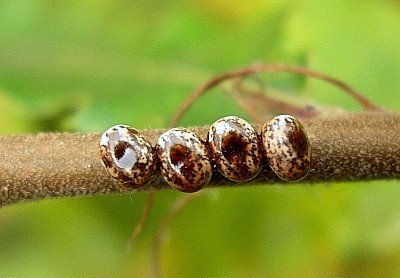
LARVA: Full-fed 60mm. Monomorphic. The newly-hatched, 4.5mm long larvae, which are black with brown tubercles, consume part of their eggshells and then wander off some distance to find suitable resting sites among the unfurling spring leaves. At this stage they sit in groups on the upper surfaces of leaves and twigs. When fully grown they become solitary and are similar to the larvae of Saturnia pavonia, in being pale green with six small yellowish tubercles per segment, a yellow subspiracular band on the abdominal segments, but with long white hairs on the tubercles. The body itself is covered with shorter white hairs. Depending on the quality of the hostplant, the larvae may undergo four or five instars. The larvae require hot, dry conditions, and can be found during April and May.
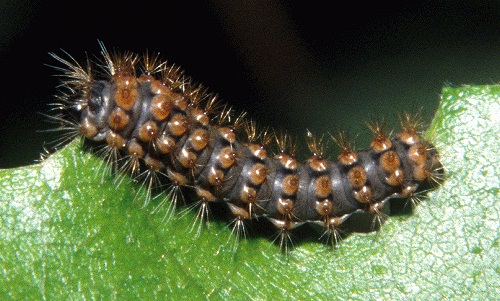
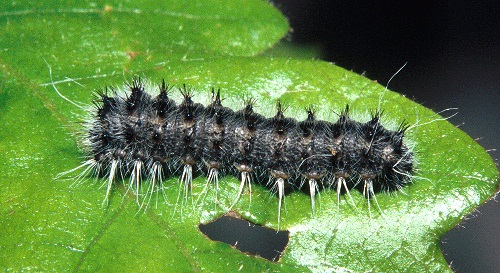
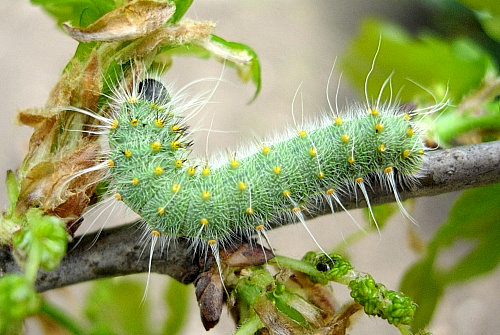
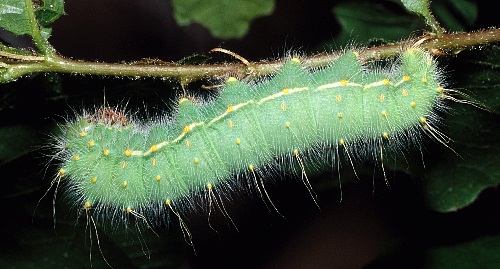
Hostplants. Mainly species of oak (Quercus), such as pedunculate oak (Quercus robur), sessile oak (Quercus petraea), white oak (Quercus pubescens), Turkey oak (Quercus cerris), cork oak (Quercus suber) and holm oak (Quercus ilex); however, larvae have also been found on beech (Fagus sylvatica), hornbeam (Carpinus betulus), black poplar (Populus nigra), white poplar (Populus alba) and various species of ash (Fraxinus), pear (Pyrus) and Prunus.
When feeding on oak the young larvae will avidly eat the immature pollen sacks of male catkins.
In captivity this subspecies can be easily reared on Salix caprea, indicating that Salix may be a hostplant in the wild.
PUPA: Rugose, mahogany-brown with a fine grey pubescence and with a yellowish, semi-transparent, photo-sensitive window between the eyes. The abdomen terminates with a pair of hook clusters. Formed in a 35mm, dark brown, double-walled, mesh cocoon. The inner wall is of a fine mesh, the outer is coarser -- the pupa is clearly visible through both. Spun up among twigs and leaves, often on or near the ground.
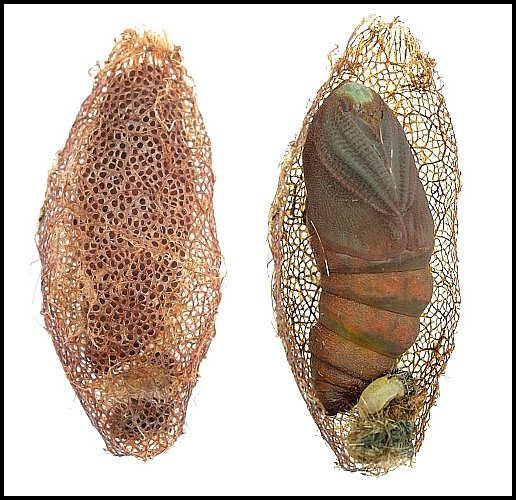
Ichneumonidae: Coelichneumon erythromerus (Rudow, 1888); Tachinidae: Exorista sorbillans (Wiedemann, 1830)
Reported in the past from the Abruzzi Mountains of central Italy as an isolated population, but this cannot be confirmed (Nässig, 2002; Nässig, Naumann & Löffler, 2016). However, this subspecies has been confirmed east of Venice (Friuli-Venezia Giulia) near the Croatian border (de Freina & Witt, 1987; Parenzan & Porcelli, 2006; Lucio Morin, iNaturalist 2011), and then from southeastern Austria (Steiermark) through Slovenia, Croatia (Abafi-Aigner, 1910), Serbia, Albania, the western Ukraine, Romania, Bulgaria (Beshkov, 1995; Beshkov & Langourov, 2004; Beshkov, 2009; Hristova & Beshkov, 2016; Anna Crassna, iNaturalist 2024) and Greece (Fritsch, Stangelmeier, Top-Jensen & Bech, 2014; Eleanna Ganotopoulou, iNaturalist 2022) to most of Turkey (Baron, 2008; Kemal, Kizildag & Koçak, 2018) and the Caucasus Mountains of the Republic of Georgia (Romanoff, 1885; Andrey Baznikin, iNaturalist 2023), Armenia (Michał Brzeziński, iNaturalist 2024) and Azerbaijan (Nässig, 1981; Zolotuhin, Didmanidze & Petrov, 2011; Nässig, Naumann & Löffler, 2016). There is also an isolated population in the mountains of Lebanon and Israel (Upper Galilee). It has also been recently recorded from the Kurdish area (Sulaymaniyah) of northern Iraq (Khudhur & Ahmed, 2020), and from Iran on the other side of the border, from the village of Darreh Tefi (Nässig, Naumann & Löffler, 2017).
De Freina & Witt (1987) note a record from Sicily, but Nässig (2002) doubts the validity of this, as do Nässig, Naumann & Löffler (2016). Also, the presence of this species in Hungary cannot be confirmed, even though Jordan (1911) gave Orsova in 'Hungary' as a locality. Originally part of the old Kingdom of Hungary, this city is now a port on the Danube river in southwestern Romania.
Extra-limital range. None.
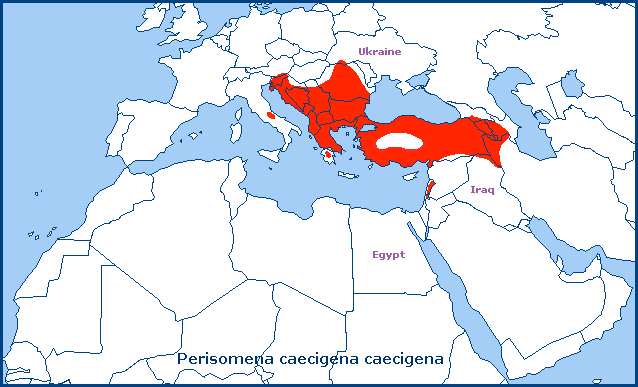
Type locality: Cyprus, [Troodos Mts.] Paphos Forest, west of Pedoulas, east of Mylikouri, 600-800m.
Holarctic; western Palaearctic region. Pleistocene refuge: Monocentric -- Atlantomediterranean subsection of the Mediterranean refuge.
Wingspan (males) 40--65mm, (females) 48--90mm. This supspecies shows a very reduced sexual dimorphism compared with subsp. caecigena; however, the individual variation is larger, with the ground colour of both sexes ranging from dark brownish-red, or dark greyish-brown over wine red, to bright greyish-brown or bright pinkish brown, with any hint of yellow generally lacking in both sexes (Nässig, 2002).
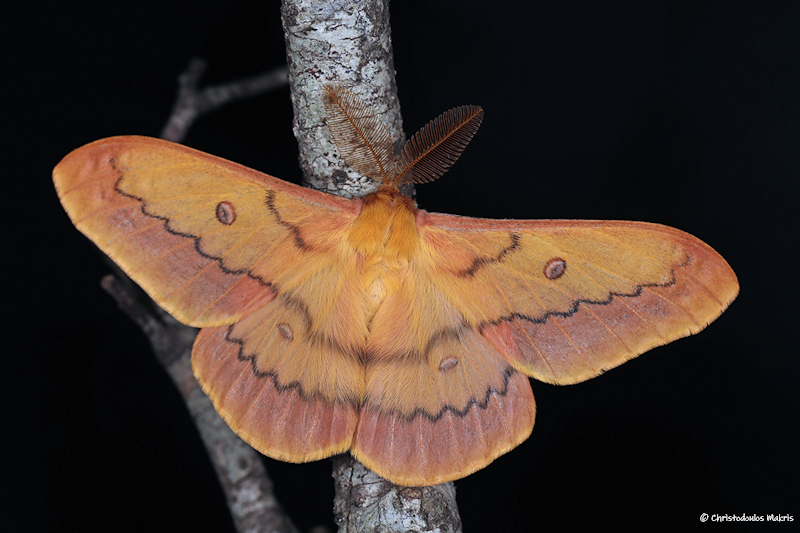
A nocturnal subspecies inhabiting dry, shrubby, open montane mixed woodland with oaks (Quercus).
Late September to early November.
As per subsp. caecigena. Full-grown larvae can be found in late May.
Hostplants. Recorded from species of Quercus and Populus (Lederer, 1855).
PUPA: As per subsp. caecigena.
Unknown.
Confined to the Troodos Mountains of Cyprus (Luca Sattin, iNaturalist 2021), where it was also found by Lewandowski & Fischer (2002). It was first reported from this island by J. Lederer in 1855, as larvae feeding on poplar (Populus) bushes in the vicinity of Stavrovouni Monastary (17km west of Larnaka).
Extra-limital range. None.
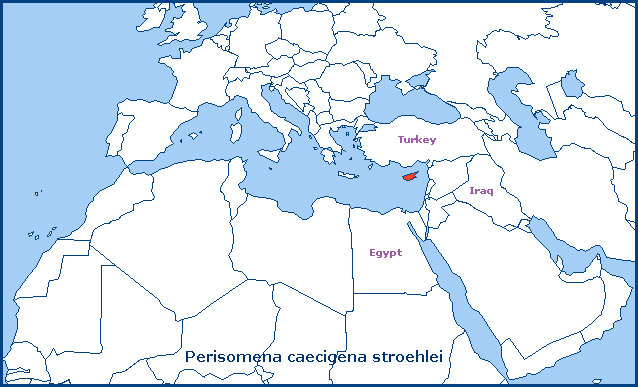
None.
 Return to species list
Return to species list